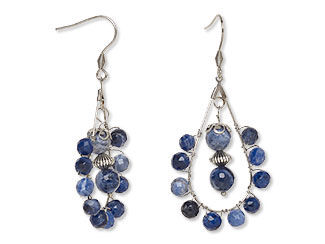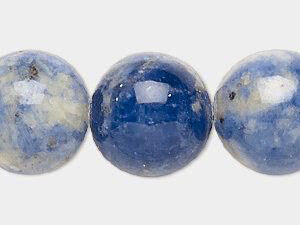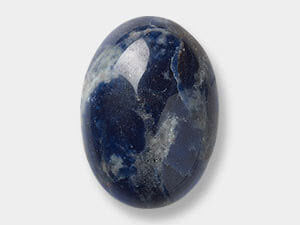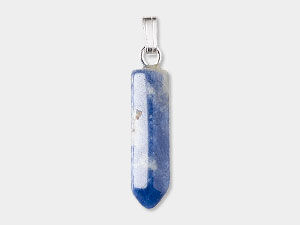Sodalite Meaning and Properties
Sodalite History
For a stone of frequent mistaken identity, sodalite is unimaginatively named for its sodium content. The more poetic "poor man's lapis" is a common nickname for this beautiful blue-and-white mineral. Sodalite and lapis lazuli can be easily mistaken for each other at first glance; however, lapis contains flecks of pyrite, which is where the stones differ. To complicate matters, lapis lazuli (which is technically a rock) may sometimes contain sodalite (which is a mineral in itself). Sodalite is sometimes also confused with azurite , dumortierite and lazulite. Additionally, in Canada, sodalite can be referred to as "Princess Blue" because it was found in Ontario in 1891 during the visit of two members of the British Royal Family.
The stone was known across the Americas before its official entry into Western mineralogy, however: around 2,600 BC, the Caral peoples traded for sodalite in what is now Peru, as did the residents of Tiwanaku in modern Bolivia.
Don't let the unimaginative name fool you; sodalite is a gorgeous gemstone with some interesting—even humorous—history and inspiring design possibilities. Watch this video to learn more about sodalite.

What are the Metaphysical Properties of Sodalite?
Sodalite is sometimes considered a guardian for heroes and heroines, especially those speaking truth to power. It's believed to have the ability to unite logic with intuition and the drive for truth with the rise of idealism. Practitioners have used sodalite to organize the mind, as it's said to promote rational thought, objectivity and perception. It is sometimes thought to cleanse lymph nodes and boost the immune system. All these balancing abilities are why sodalite is often used in groups with other stones and among multiple users. Sodalite is assigned to the western astrological sign Sagittarius. In feng shui, it is thought to possess water energy.
What Chakra is Sodalite?
Chakras are viewed as vital energy centers that connect body, mind and spirit. These centers are believed to affect everything from emotional well-being to how we express ourselves in the world. Wearing a chakra bracelet—adorned with meaningful gemstones—is a beautiful and natural way to support energetic balance throughout the day. Sodalite is linked to both the throat chakra and the third eye chakra and is thought to encourage clear communication, intuition and spiritual growth. It’s also said to promote a long, healthy life.
Third Eye Chakra (Anja) - Blue or Indigo
- Location: pituitary gland
- Represents: awareness; self-awareness; inner guidance; intuition; focus
- Emotional issues: imagination; acceptance and guidance of the higher self; decision-making
- Spiritual issues: balancing base instincts with higher impulses
- Physical issues: damage to brain tissues; eyesight; endocrine system
- Gemstones: lapis lazuli, sodalite
Throat Chakra (Vishuddha) - Teal or Light Blue
- Location: throat (thyroid)
- Represents: communication; growth via expression; secrets
- Emotional issues: communication; independence; listening; creativity; fluent thought
- Spiritual issues: sense of self; freedom to speak truth
- Physical issues: thyroid; esophagus; speech and other communication problems
- Gemstones: aquamarine, blue lace agate, turquoise, sodalite
What is Sodalite Made From?
While blue (with white inclusions) is the most common color of sodalite, this stone can also be found in grey, green, yellow, light red and lavender varieties. (The purple variety of sodalite is called Hackmanite.) Sodalite properties include fluorescing orange under ultraviolet light, except for Hackmanite. That variant displays tenebrescence instead, becoming deeper and richer in color after UV exposure (although the effect fades after time).
Sodalite deposits are found in Afghanistan, Brazil, Greenland and Canada, as well as in Maine and Arkansas within the United States.
- Mineral Information: Chloric sodium aluminum silicate
- Chemical Composition: Na8(CI2Al6Si6O24)
- Color: Blue with occasional streaks of white
- Hardness: 5-1/2 to 6 (Mohs)
- Specific Gravity: 2.13 – 2.29
- Refractive Index: 1.48
How Do You Clean Sodalite?
While sodalite is a tough stone (long-lasting and durable), it is not a hard one (can be scratched). It is sensitive to pressure, high temperatures and household cleaners. Avoid exposing sodalite to bleaches or sulfuric acid. Clean with warm, soapy water and a soft cotton cloth.
Sodalite FAQ
Q: Is sodalite the same as lapis lazuli?
A: While both sodalite and lapis lazuli share a dark celestial blue hue and a marbling of a lighter color, they are distinct gemstones. Sodalite is known for its white or off-white veining which lapis lazuli can share, but lapis lazuli has a unique feature—a scattering of golden pyrite flecks like stars in a midnight sky. The color of sodalite is not as saturated, and when it’s scratched, it leaves a white streak, in contrast to lapis lazuli’s consistent blue.
Q: Why is sodalite less expensive than lapis?
A: Several factors contribute to the price difference between lapis lazuli and sodalite. Lapis lazuli is less common, and high-quality specimens are especially rare. In contrast, sodalite is far more abundant. Lapis stands out with its intense blue color, shimmering golden pyrite flecks and a rich history dating back to ancient civilizations. These qualities have made it a customer favorite and increased its market value.
Q: Can I use sodalite beads for stretch bracelets?
A: Sodalite is a popular choice for stretch bracelets , even though its Mohs hardness of 5-1/2 to 6 places it on the softer side. For greater durability—especially in bracelets worn daily—gemstones with a hardness of 6 or higher are generally recommended.
Q: Are all sodalite beads the same shade of blue?
A: While sodalite is best known for its deep blue tones, it also occurs in a range of colors—including shades of gray, green, purple and pink. Its veining, typically white or cream, can also appear in a surprising spectrum of hues, adding unique character to each stone.
Q: Can you pair sodalite with gold-toned beads and components?
A: Sodalite’s rich blue tones pair beautifully with gold-toned beads and findings, while its white streaks make it equally striking alongside silver-toned components. This versatility makes it a favorite for a wide range of jewelry styles.
Designing with Sodalite
Beaders who love deep, rich blue stones can't keep their hands off sodalite. Avoid using sodalite in anklets, bracelets and rings. With its low Mohs hardness, it's recommended to limit its use to jewelry styles that are unlikely to be scratched: earrings, necklaces, pendants, etc.
The violet-blue color of sodalite lets designers play with the same color palettes as designs with lapis lazuli and azurite—at a fraction of the cost. The cool blues of the stone work well with silver, yet contrast beautifully with gold. Different color schemes open up easily with sodalite: a medley of related colors in blues, violets and greys featuring silver, grey moonstone , dumortierite and blue lace agate —as well as being accented by complementary colors of warm copper , fiery orange carnelian and scintillating sunstone .
A Few Design Inspirations to Get You Started
Join jewelry maker Rose as she guides you in creating a beautiful pair of sodalite earrings. Enhanced by gold-plating, which adds a touch of elegance, these leverback earrings beautifully complement the sodalite. They also ensure that your earrings stay in place, making for a stylish and practical accessory.

Shop for Sodalite
**Please note that all metaphysical or healing properties listed are collected from various sources. This information is offered as a service and not meant to treat medical conditions. Fire Mountain Gems and Beads® does not guarantee the validity of any of these statements.
How did you like this resource? Your feedback helps us provide resources that matter to you most.
Copyright Permissions
All works of authorship (articles, videos, tutorials and other creative works) are from the Fire Mountain Gems and Beads® Collection, and permission to copy is granted for non-commercial educational purposes only. All other reproduction requires written permission. For more information, please email copyrightpermission@firemtn.com.






